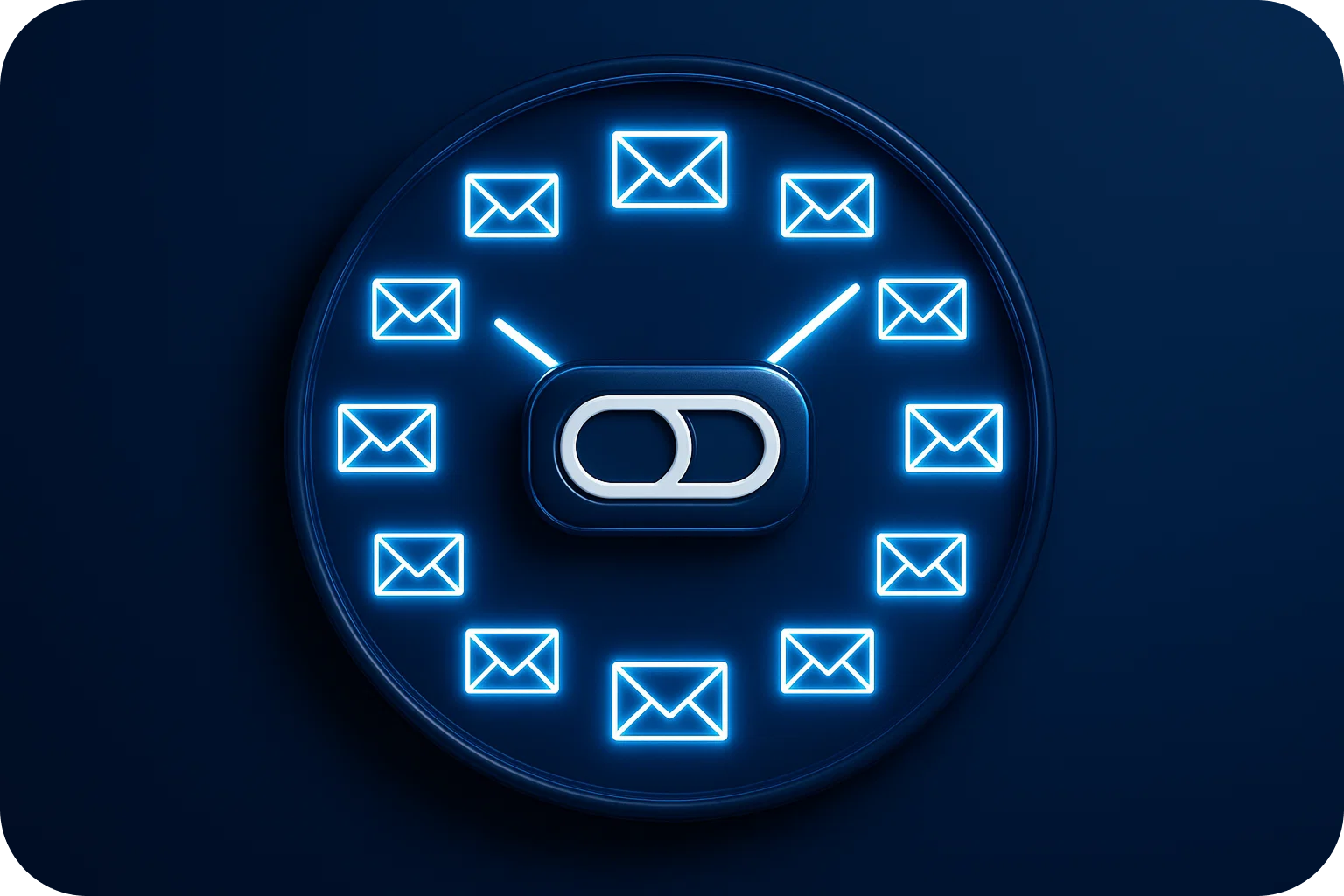The 5-Second Subject Line Test: Cognitive Science Behind Inbox Attention

Your subject line has exactly 5 seconds to win or lose the battle for inbox attention. That's not a marketing cliche, it's cognitive science.
Research shows that the average professional spends just 3-5 seconds scanning an email before deciding whether to open, ignore, or delete it. In that microscopic window, your subject line must trigger the right neurological response or vanish into the digital void.
Understanding the psychology behind this split-second decision can transform your cold email open rates from mediocre to exceptional. Let's explore the cognitive mechanisms at play and how to leverage them strategically.
The Neuroscience of Inbox Scanning
When someone opens their inbox, their brain doesn't read; it hunts. The prefrontal cortex activates pattern recognition systems, scanning for signals of relevance, urgency, or value while simultaneously filtering out noise.
This process happens largely at the subconscious level. Before your prospect consciously "reads" your subject line, their brain has already made preliminary judgments based on:
Visual pattern recognition: Length, capitalization, special characters, and formatting create instant impressions before a single word registers consciously.
Semantic triggers: Certain words and phrases activate different neural pathways. Terms like "question," "quick," or their name trigger attention mechanisms, while words like "opportunity" or "introducing" often trigger spam filters, both digital and mental.
Emotional valence: The brain's amygdala processes emotional content faster than rational content. Subject lines that evoke curiosity, concern, or relevance get prioritized over neutral statements.
Cognitive load assessment: Your prospect's brain instantly calculates the perceived effort required to process your email. High cognitive load equals immediate dismissal.
Understanding these mechanisms allows you to craft subject lines that work with human neurology rather than against it.
Why the 5-Second Rule Matters for Cold Email
Cold emails face a unique challenge: zero existing relationship equity. When someone receives an email from a known contact, their brain applies different processing rules—familiarity creates cognitive shortcuts that lower resistance.
Your cold email has no such advantage. The subject line must compensate for this deficit by delivering immediate, unmistakable value signals.
The 5-second test forces discipline. If you cannot communicate relevance in 5 seconds, your subject line is too complex, too vague, or too self-serving. This constraint aligns perfectly with how the brain actually processes information under conditions of limited attention.
Consider the typical inbox scenario: 47 unread emails, back-to-back meetings, constant Slack notifications. Your prospect's cognitive resources are depleted. Decision fatigue has set in. In this environment, simplicity wins.
The Four Cognitive Principles of High-Converting Subject Lines
1. Specificity Reduces Cognitive Load
Generic subject lines force the brain to work harder. "Thoughts on improving your sales process" requires the recipient to imagine what those thoughts might be, assess relevance, and estimate value, all before opening.
Compare that to: "3-step fix for your Salesforce duplicate lead problem"
The specific version does the cognitive work for your prospect. Their brain can instantly assess: Do I use Salesforce? Do I have a duplicate lead problem? Three steps sound manageable. Open or delete, decision made in under 3 seconds.
Specificity also triggers the brain's pattern-matching systems. If the subject line describes a problem your prospect actively experiences, recognition happens automatically and powerfully.
2. Curiosity Creates a Knowledge Gap
Behavioral economist George Loewenstein identified the "information gap theory", when people perceive a gap between what they know and what they want to know, they experience curiosity as an uncomfortable sensation that demands resolution.
Effective subject lines create this gap deliberately: "The deliverability mistake 73% of cold emailers make"
This works because it implies: (1) there's a common mistake, (2) you might be making it, (3) the answer exists and is available. The brain experiences mild discomfort from not knowing and seeks resolution through opening the email.
The key is balance. Too vague ("You won't believe this") triggers skepticism rather than curiosity. Too complete ("Here's why you should warm up email addresses before sending") closes the gap and eliminates the opening motivation.
3. Relevance Signals Bypass Spam Filters
Both algorithmic and mental spam filters look for relevance signals. The brain asks: "Is this for me, specifically?"
Personalization helps, but generic personalization ("Hey {{FirstName}}") has become a spam signal itself. Sophisticated relevance requires research-based specificity.
Examples of strong relevance signals:
- Role-specific language: "For RevOps leaders scaling from 10 to 50 reps"
- Company-specific observations: "Noticed your team is hiring 3 SDRs."
- Timing-based relevance: "Before your Q1 planning session"
- Problem-specific framing: "If your team uses multiple sending domains"
These signals tell the brain: "This sender understands my specific context." That understanding creates credibility and lowers resistance.
4. Brevity Respects Cognitive Constraints
The optimal subject line length is 6-10 words or 40-60 characters. This isn't arbitrary; it reflects both technical constraints (mobile preview limits) and cognitive constraints (working memory capacity).
Longer subject lines increase cognitive load. The brain must process more information to extract meaning, which triggers the mental "too much effort" response under conditions of limited attention.
Shorter isn't always better, though. Subject lines under 4 words often lack sufficient context to trigger relevance recognition. "Quick question" could be about anything. "Quick question about your email infrastructure" provides just enough context.
Applying the 5-Second Test: A Practical Framework
To evaluate any subject line, ask these questions in sequence:
Scan test: Show your subject line to someone unfamiliar with your campaign for exactly 5 seconds. Can they articulate what the email is about and why it might matter to the recipient? If not, revise.
Relevance test: Does the subject line contain at least one specific detail that proves you understand the recipient's context? Generic subject lines fail this test.
Curiosity test: Does the subject line create a knowledge gap without being clickbait? If it could appear in a spam folder, revise.
Value test: Can the recipient immediately identify what they'll gain by opening? "Benefit for you" should be implicit or explicit.
Simplicity test: Can you remove any words without losing meaning? Every unnecessary word increases cognitive load.
Common Subject Line Mistakes That Fail the 5-Second Test
Mistake 1: Leading with your company or product, "Mailpool.ai - Revolutionary email infrastructure," tells the recipient nothing about why they should care. It fails the relevance test immediately.
Mistake 2: Vague value propositions "Helping companies scale their outreach" is meaningless. Every cold email claims to help. Specificity is what creates differentiation.
Mistake 3: False urgency "Last chance!" or "Urgent response needed" trigger spam recognition patterns. Unless there's genuine, explainable urgency, avoid these phrases.
Mistake 4: Question overload "Are you struggling with deliverability, domain reputation, and inbox placement?" asks the brain to process three concepts simultaneously. Pick one.
Mistake 5: Clever wordplay Puns and creative language increase cognitive load. Your prospect's brain must first decode the wordplay, then extract meaning. Under time pressure, they'll simply move on.
Testing and Optimization
The 5-second rule provides a qualitative framework, but quantitative testing remains essential. A/B test subject line variations with these specific hypotheses:
- Specificity level: Generic vs. specific problem statement
- Curiosity vs. directness: Knowledge gap vs. complete value proposition
- Length variations: 6 words vs. 10 words
- Personalization depth: Name only vs. company-specific observation
Track not just open rates but reply rates and conversion rates. A subject line that generates opens but no engagement has failed, it created false expectations that the email body couldn't fulfill.
The Inbox Attention Economy
Attention is the scarcest resource in modern business communication. Your subject line competes not just with other cold emails but with urgent client requests, internal communications, and personal messages.
Winning this competition requires understanding that your prospect's brain is not carefully reading and evaluating, it's rapidly scanning and filtering. The 5-second test aligns your subject line strategy with this neurological reality.
Master this principle, and your cold emails will consistently clear the first and most critical hurdle: getting opened. Everything else, your value proposition, your call to action, your conversion strategy, depends entirely on winning those first 5 seconds.
The inbox attention battle is won or lost before your prospect consciously decides anything. Make those 5 seconds count.
More articles
Get started now




%201.png)




.png)
